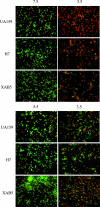Acid tolerance of biofilm cells of Streptococcus mutans
- PMID: 17630302
- PMCID: PMC2042095
- DOI: 10.1128/AEM.01049-07
Acid tolerance of biofilm cells of Streptococcus mutans
Abstract
Streptococcus mutans, a member of the dental plaque community, has been shown to be involved in the carious process. Cells of S. mutans induce an acid tolerance response (ATR) when exposed to sublethal pH values that enhances their survival at a lower pH. Mature biofilm cells are more resistant to acid stress than planktonic cells. We were interested in studying the acid tolerance and ATR-inducing ability of newly adhered biofilm cells of S. mutans. All experiments were carried out using flow-cell systems, with acid tolerance tested by exposing 3-h biofilm cells to pH 3.0 for 2 h and counting the number of survivors by plating on blood agar. Acid adaptability experiments were conducted by exposing biofilm cells to pH 5.5 for 3 h and then lowering the pH to 3.5 for 30 min. The viability of the cells was assessed by staining the cells with LIVE/DEAD BacLight viability stain. Three-hour biofilm cells of three different strains of S. mutans were between 820- and 70,000-fold more acid tolerant than corresponding planktonic cells. These strains also induced an ATR that enhanced the viability at pH 3.5. The presence of fluoride (0.5 M) inhibited the induction of an ATR, with 77% fewer viable cells at pH 3.5 as a consequence. Our data suggest that adhesion to a surface is an important step in the development of acid tolerance in biofilm cells and that different strains of S. mutans possess different degrees of acid tolerance and ability to induce an ATR.
Figures




References
-
- Balzar Ekenbäck, S., L. E. Linder, M.-L. Sund, and H. Lönnies. 2001. Effect of fluoride on glucose incorporation and metabolism in biofilm cells of Streptococcus mutans. Eur. J. Oral Sci. 109:182-186. - PubMed
-
- Beighton, D., J. M. Hardie, and R. A. Whiley. 1991. A scheme for the identification of viridans streptococci. J. Med. Microbiol. 35:367-372. - PubMed
-
- Bibby, B. G., and M. van Kesteren. 1940. The effect of fluorine on mouth bacteria. J. Dent. Res. 19:391-402.
-
- Bowden, G. H. W. 1991. Which bacteria are cariogenic in humans? p. 266-286. In N. M. Johnson (ed.) Dental caries, vol. 1. Markers of high and low risk groups and individuals. Cambridge University Press, Cambridge, United Kingdom.
Publication types
MeSH terms
Substances
LinkOut - more resources
Full Text Sources
Miscellaneous

